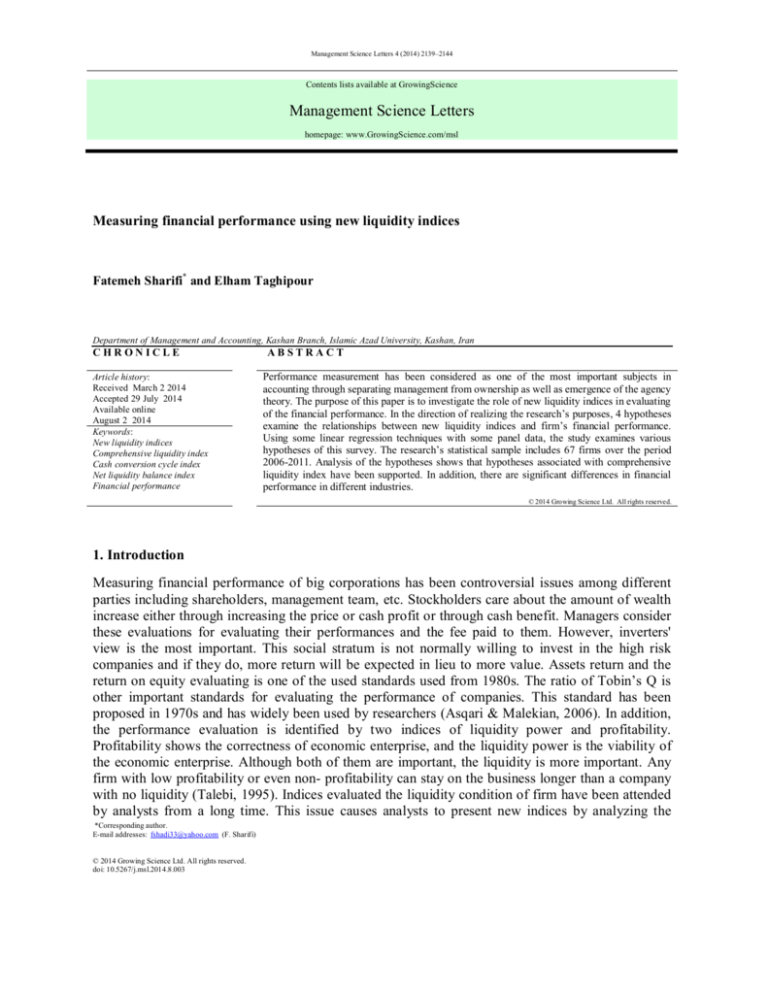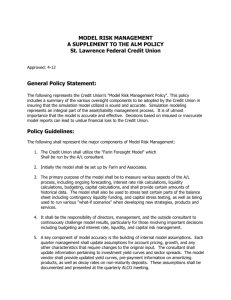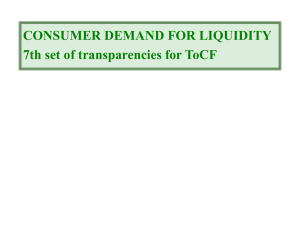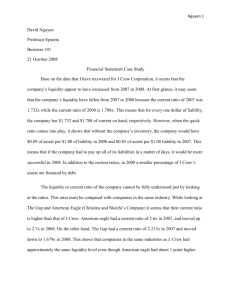
Management Science Letters 4 (2014) 2139–2144
Contents lists available at GrowingScience
Management Science Letters
homepage: www.GrowingScience.com/msl
Measuring financial performance using new liquidity indices
Fatemeh Sharifi* and Elham Taghipour
Department of Management and Accounting, Kashan Branch, Islamic Azad University, Kashan, Iran
CHRONICLE
Article history:
Received March 2 2014
Accepted 29 July 2014
Available online
August 2 2014
Keywords:
New liquidity indices
Comprehensive liquidity index
Cash conversion cycle index
Net liquidity balance index
Financial performance
ABSTRACT
Performance measurement has been considered as one of the most important subjects in
accounting through separating management from ownership as well as emergence of the agency
theory. The purpose of this paper is to investigate the role of new liquidity indices in evaluating
of the financial performance. In the direction of realizing the research’s purposes, 4 hypotheses
examine the relationships between new liquidity indices and firm’s financial performance.
Using some linear regression techniques with some panel data, the study examines various
hypotheses of this survey. The research’s statistical sample includes 67 firms over the period
2006-2011. Analysis of the hypotheses shows that hypotheses associated with comprehensive
liquidity index have been supported. In addition, there are significant differences in financial
performance in different industries.
© 2014 Growing Science Ltd. All rights reserved.
1. Introduction
Measuring financial performance of big corporations has been controversial issues among different
parties including shareholders, management team, etc. Stockholders care about the amount of wealth
increase either through increasing the price or cash profit or through cash benefit. Managers consider
these evaluations for evaluating their performances and the fee paid to them. However, inverters'
view is the most important. This social stratum is not normally willing to invest in the high risk
companies and if they do, more return will be expected in lieu to more value. Assets return and the
return on equity evaluating is one of the used standards used from 1980s. The ratio of Tobin’s Q is
other important standards for evaluating the performance of companies. This standard has been
proposed in 1970s and has widely been used by researchers (Asqari & Malekian, 2006). In addition,
the performance evaluation is identified by two indices of liquidity power and profitability.
Profitability shows the correctness of economic enterprise, and the liquidity power is the viability of
the economic enterprise. Although both of them are important, the liquidity is more important. Any
firm with low profitability or even non- profitability can stay on the business longer than a company
with no liquidity (Talebi, 1995). Indices evaluated the liquidity condition of firm have been attended
by analysts from a long time. This issue causes analysts to present new indices by analyzing the
*Corresponding author.
E-mail addresses: fshadi33@yahoo.com (F. Sharifi)
© 2014 Growing Science Ltd. All rights reserved.
doi: 10.5267/j.msl.2014.8.003
2140
defects of traditional indices (Khoshtinat & Namazi, 2004). The new indices include comprehensive
liquidity index, cash conversion cycle index, net liquidity balance index. These indices try to consider
the defects resulting from traditional indices of liquidity that these defects occur because of not
considering the details of firm’s liquidity condition. According to close relation between liquidity
condition of firms and their financial performance in this research, the role of new indices of liquidity
in evaluating financial performance of firms is investigated. There are some new definitions for
liquidity as follows,
Comprehensive liquidity index: it eliminates the problem related to not considering the rate of
liquidity of current assets and the time of debt payback by calculating the weighted average current
ratio (Melyk & Birita, 1974).
Cash conversion cycle index: cash conversion cycle is the net interval cycle between paying back
debts and receiving cash from the place of debt collection. The firm shows a better liquidity whatever
this cycle is shorter (Gitman, 1974).
Net liquidity balance index: in this index, cash balance and stocks are attended to show the condition
of firm liquidity. This index shows the store of the real liquidity of the firm in association with nonpredictable needs (Shulman & Cox, 1985).
Some researchers compared the relationship between traditional indices and new indices of liquidity
in the Tehran Stock Exchange for auto industry. This research was carried out by using traditional
and new indices of liquidity over the period 2004-2009, and the result showed there were a positive
correlation between traditional ratio and new indices of liquidity. All standard proposed in their
researches were suitable for evaluating the liquidity in the framework of its assumptions and each of
them considered one dimension of liquidity issue. Khani and Haqiqi (2012) evaluated the increasing
and relative content of information of internal return rate based on the cash recovery to the rate of
assets return in firms accepted in Tehran stock exchange. In this research, both the index of stock
return rate and ratio of Tobin’s Q were used as basic indices, and the amounts of explaining these
two basic indices were tested by indices of internal return rate based on cycling cash and assets return
by using multivariable regression. The result showed that internal return rate based on cash cycling
had a relative and increasing informative content than assets return rate. Wang (2002) studied a
relationship of liquidity management and profitability and firm value of a 1555 Japan firms and 375
Taiwan firms over the period 1996-1985. The result of his research showed there were negative and
significant relationship between cash converting cycle and indices of profitability. Additional to this
daringly, liquidity management occurred by reducing the cash conversing cycle caused to improve
the firm performance, finally increasing the firm value.
Nobanee and AlHajjar (2009) investigated the relationship between managing the turnover capital,
firm performance and activating the cash turnover of 5802 firms over the period 1990-2004. The
results showed that manager could increase profitability and cash turnover of firm by decreasing the
cash conversion cycle and the receipt of receivable account. In addition, decreasing the stock
conversion cycle and increasing the account payable due date cycle could lead to decrease the
profitability and cash turnover of firm. Yalcin et al. (2012) proposed a new financial performance
evaluation approach to rank the companies of each sector for some Turkish manufacturing firms. For
this purpose, a hierarchical financial performance evaluation model was structured based on the AFP
and VFP main-criteria and their sub-criteria. They used fuzzy analytic hierarchy process (FAHP) to
determine the weights of the criteria. The companies were ranked according to their own
manufacturing sector by using two multi criteria decision making techniques named TOPSIS and
VIKOR, comparatively. The results showed that the obtained ranks of the companies by these
methods were almost the same compared with their own sectors.
F. Sharifi and E. Taghipour / Management Science Letters 4 (2014)
2141
2. The proposed study
The Main hypothesis: There is a relationship between new indices of liquidity and financial
performance of manufacturing firm accepted in Tehran Stock Exchange. There are also four subhypothesis as follows,
1- There is a relationship between cash conversion cycle index and financial performance.
2- There is a relationship between net liquidity balance index and financial performance.
3- There is a relationship between comprehensive liquidity index and financial performance.
4- Financial performances of manufacturing firms of different industries differ from each other on the
basis of new indices of liquidity.
The manufacturing firms accepted in Tehran Stock Exchange during 2006-2011 were the statistical
society of this research by considering some specific characteristics. First, they must be profitable,
they all must have the same fiscal calendar ending March, no banks, holding or financial institution
was permitted in the survey. In addition, they should have had any change on their fiscal year, all
information must be available and there must be no interruption on financial and trading activities. In
this research, randomly sample size is obtained by the Cochran formulation and 67 firms were needed
in this research as statistical sample. The number of firms was randomly selected among firms
become members of Tehran Stock Exchange and they were placed in form of 8 industries including
chemical, medicinal, cement-gypsum-lime, manufacturing automobiles and parts, basic metals,
foodstuffs, non- metal minerals , machineries and equipment. Since all firms of statistical society had
the same opportunity to select and our purpose was to generalize the results, the method of randomly
simple sampling has been used. According to kind of data and available analytic method in this
research, panel data has been used, because relation of liquidity indices and financial performance of
firms, dependent and independent variables are investigated, differently. These variables were tested
among various firms and in a 6-year period. To estimate the regression model related to combined
data, one of methods of common effects, fixed effects, and random effects was used. In this research,
results obtained by using the distinguishing Lymer’s F test and Hausman’s test showed the priority of
using the random effects method for estimating all regression models in comparison with fixed
effects method. Because of non-static nature of most economic variables in level, estimating
econometrics patterns in time interval by these variables may lead to a false regression. Therefore,
using economic variables in econometrics patterns are dependent on performing reliable test. In this
research, the unit root and Dickey Fuller tests have been used to determine the reliability of the model
variables. To carry out the statistical tests, SPSS 16, Eviews 7 software have been used to analyze the
data. The study considers a regression model in form of yi f ( x1 , x2 , x3 ), i 1, 2,3 where independent
variables are new indices of liquidity and dependent variable is financial performance. In other
words, y1 is ratio of return of equity, y2 is the asset return ratio and y3 is Tobin’s Q ratio. In addition,
x1 is the net liquidity balance index, x2 is the cash conversion cycle index and x3 is the
comprehensive liquidity index. Let x1 : NLB (CASH MKT AP) / TA where NLB= net cash
balanced, CASH= cash, MKT=sellable stock, AP = payable document, TA=total assets. In addition,
x2 : CCC OC PP , OC=INVP+RP, and PP=PA/DCOGS where CCC= the cash conversion cycle,
OC= operational cycle, PR= the cycle of debt collection, INVP=the cycle of keeping goods inventory,
PA= balance account payable and DCOGS= cost of daily goods sold. x3 : ACR=ACA/LCA where
ACR, ACA and LCA are comprehensive liquidity index, adjusted current asset and adjusted current
debt, respectively. For all relationships, we consider yi 1 x1 2 x2 3 x3 .
3. The Results
To test the research’s hypothesis, first, variables normality is investigated by Kolmogorov–Smirnov
test. According to Table 1, the assumption of normality of variable of return of equity is supported.
2142
However, the assumption of normality of variable of asset return and Tobin’s Q ratio is supported
after performing the logarithm.
Table 1
The results of Kolmogorov- Smirnov test
Variable
Return on equity
Return on asset
Tobin’s Q ratio
Statistics of
Kolmogorov- Smirnov
0.934
2.457
2.973
Significance level
0.347
0.000
0.000
Statistical result after
performing logarithm
Significance level
1.140
1.042
0.149
0.228
Then reliability of dependent and independent variables is investigated. According to unit root test for
variables whose P-Value amount is lower than 0.05, they are reliable during the research. The results
are shown in Table 2.
Table 2
Testing the reliability of research variables
Variables
Return on equity
logarithm return on asset
logarithm Tobin’s Q
Statistics of Dickey Fuller
-20.024
-8.4818
-5.7629
Significance level
0.000
0.000
0.000
Table 3
The statistic of Durbin-Watson and F- statistics
Variables
Return on equity
logarithm return on assets
logarithm Tobin’s Q
Durbin-Watson
2.399
0.8217
0.8784
F-value
0.048
4.82
3.74
Sig.
0.986
0.0026
0.011
Determinant balance coefficient
0.007
0.02
0.02
In addition, the statistic of Durbin-Watson is used in regressive model for investigating specification
error. In other word, if rest of regression shows a systematic pattern, the specification error will be
existed. Additional to this F statistic, the multivariable regression model is used for testing
significance. If calculative F is higher than standard amount of F in a specific level, the total
significance of regression is accepted in level of significance. After investigating the reliability of
variables, confidence of lack of continuous correlation and significance of estimated regression model
for two variables (logarithm of asset return and ratio of Tobin’s Q) coefficient of independent
variables are calculated, as it is shown in Table 4. T statistic is used for testing significance of
coefficient of model, so, if P-Value ,the coefficient of dependent variable is lower than 0.05, the
significance of mentioned coefficient in the model is shown.
Table 4
The results testing the relationship between ROA Ln ROA and Tobin’s Q
Dependent variable
Return on equity
Logarithm on return assets
Logarithm on Tobin’s Q
Independent variable
Cash conversion cycle
Liquidity comprehension
Net liquidity balance
Cash conversion cycle
Liquidity comprehension
Net liquidity balance
Cash conversion cycle
Liquidity comprehension
Net liquidity balance
Regression coefficient
-0.0095
-2.29
14.99
-9.49
0.212
0.95
0.000
0.104
-0.269
T statistic
-0.32
-0.20
0.12
-0.56
3.32
1.41
-1.74
2.67
-0.660
Significance level
0.74
0.84
0.89
0.57
0.001
0.15
0.08
0.0077
0.50
( ROA) y2 2.53 9.49 x1 0.21x2 0.95 x3
(1)
(QTobin) y3 0.19 0.0001x1 0.10 x2 0.26x3
(2)
2143
F. Sharifi and E. Taghipour / Management Science Letters 4 (2014)
Since there is no relationship between return on equities (ROA), Tobin-Q and new indices of
liquidity, non- parametric correlation test is used for these two variables and the results are shown in
Table 5-1. According to normality of three dependent variables (Return on equity, Ln Asset return,
Ln Ratio of Tobin’s Q) parametric correlation test is used for these three variables, its results are
shown in table 5-2. In addition, Analysis of variance is used foe comparing the difference of financial
performance of firms in different industries; its results are shown in Table 6.
Table 5-1
Spearman correlation coefficient among research variables
Variable
Return on equity
Return on Assets
Ratio on Tobin’s Q
Cash conversion cycle
-0.018(0.718)
0.087(0.081)
-0.86(0.085)
Liquidity comprehension
0.013(0.790)
0.114(0.022)
0.080(0.107)
Net liquidity balance
0.064(0.197)
0.113(0.024)
-0.009(0.850)
Table 5-2
Pearson correlation coefficient among research variables
variable
Return on equity
Ln Return on Assets
LN Ratio on Tobin’s Q
Cash conversion cycle
-0.124(0.013)
-0.076
-0.097(0.052
Liquidity comprehension
0.118(0.018)
0.178(0.000)
0.137(0.006)
Net liquidity balance
0.033(0.510)
0.064(0.202)
-0.025(0.615)
Table 6
The results of Analysis of Variance
Variable
F
Sig.
Return on equity
1.052
0.394
Return on Assets
9.670
0.000
Ratio on Tobin’s Q
18.162
0.000
4. Discussion and conclusion
First hypothesis: according to research finding and Table 4 and 5, there is no relationship between
cash conversion index and the ratio of asset return and ratio of Tobin’s Q. These results are consistent
with finding of Smith and Bridgeman (1997). One reason for lack of relation between cash
conversion index and the ratio of asset return is that the duration of cash conversion index was one of
the determinant factors of needed net liquidity. It seems that investigated firms did not have exact
predictions about estimating the amount of future sell. As a result, this issue led to making
conservative strategies in capital management, and lack of optimal allocation of capital to elements of
cash conversion index. However, according to finding of research, there are reverse relationship
between cash conversion cycle index and return on equity in 5% level. These results are consistent
with finding of Nobanee and Hajjar (2009) and Eljelly (2004).
Second hypothesis: according to the research, it is shown that there is a direct relation between net
cash balance index and the ratio of assets return, but, it does not have relation to ratio of Tobin’s Q.
net cash balance index shows the storage of real liquidity of firm in relation to non-predictable short
time commitments , because if the firm encounters the shortage of liquidity and want to resort to
other current assets for help ( goods stock and financial claim) , it is compelled to suffer a costs. In
this method, generally, goods inventory and debt claim are not considered. Additionally, payable
documents, means current debts having interest, just consider as binding debts in calculating the net
cash balance index. Because of non-logical value of stock market of firms and provided false return
rate for firms stock, the presence of high inflation in Iran, non-efficiency of Tehran Stock Exchange,
the hypothesis related to Tobin’s Q seems to be rejected. It is supported in different researches such
as Nasrolahi (1992), Fadaeenejad (1995).
Third hypothesis: According to research’s finding, there are positive and significant relations between
comprehensive liquidity indices by the asset return logarithm and logarithm of ratio of Tobin’s Q.
There are direct relationship between comprehensive liquidity index and return on equity. There is no
linear relationship between three independent variables, comprehensive liquidity index, cash
2144
conversion cycle index, net liquidity balance index, and dependent variable of return on equity in
simultaneous investigation of total effect. There is a linear relationship among three independent
variables, comprehensive liquidity index, cash conversion cycle index, net liquidity balance index,
and the logarithm of ROA and logarithm of ratio of Tobin’s Q ratio. However, the comprehensive
liquidity index has a significant and positive effect on logarithm of asset return and logarithm of
Tobin’s Q ratio.
Forth hypothesis: financial performances of manufacturing firms of different industries differ from
each other on the basis of new indices of liquidity. In this hypothesis, according to Table 5 and the
comparison of financial performance ratio including the return on equity, ROA, Tobin’s Q ratio in 8
industries, there are significant difference among financial performance of firms according to
observed asset return ratio and Tobin’s Q ratio, while there are no significant difference among the
ratio on equity. Analysis of research hypothesis shows that hypothesis related to comprehensive
liquidity index has been supported. In addition, there is a significant difference among financial
performance of manufacturing firms in 8 different industries. Generally, new indices of liquidity
present an exact image of financial information to users in evaluating financial performance of firms,
and it can effectively be a guide of users for making optimal decisions.
References
Asqari, G. & Malekian, A. (2006). Relation between Economic Value Added and Rate Return Asset in
Evaluating Performance of Firms Accepted in Stock Exchange. Economic Magazine, 24(33), 54-55.
Eljelly, A. M. (2004). Liquidity-profitability tradeoff: an empirical investigation in an emerging
market. International Journal of Commerce and Management,14(2), 48-61.
Fadainejad, M. (1995). Weak form test of performance of investment and Tehran Stock Exchange. Financial
Research Magazines. 5-6, 3-26 [In Persian].
Gitman, L. J. (1974). Estimating corporate liquidity requirements: a simplified approach. Financial
Review, 9(1), 79-88.
Khani, E., Haghighi, M. (2012). Increasing and proportional concepts of data about internal rate return based
on cash recovery to rate return assets in firms accepted in Tehran stock Exchange. Accounting Knowledge
Magazine, 3(10), 71-92.
Khoshtinat, M., & Namazi, Z. (2004). Correlation of new and traditional cash indices. Accounting Studying
Periodical, 7, 55-76.
Melyk, L. Z., & Birita. (1974). Comprehensive liquidity index as a measure of corporate liquidity. Scientific
and Behavioral Foundation of decision sciences. (Atlanta), 162-165.
Nasroallahi, Z. (1992). Analysis Performance of Stock Exchange in Iran . Thesis of Economic M.A. Teacher
Training University.
Nobanee, H., & AlHajjar, M. (2009). Working Capital Management, Operating Cash Flow and Corporate
Performance. SSRN: 1471236.
Shulman, J. M., & Cox, R. A. (1985). An integrative approach to working capital management. Journal of
Cash Management, 5(6), 64-68.
Smith, M. B., & Begemann, E. (1997). Measuring association between working capital and return on
investment. South African Journal of Business Management, 28(1), 1-4.
Taleb Bidekhti, A., & Faraji, F. (2011). Comparable examination between new and traditional cash indices in
Tehran Stock Exchange –Automobile industry. Financial Knowledge of Analyzing Stock Holders, 4(11),
55-79
Talebi, M.(1995). Knowing cash dimensions and management of in firms. Financial Research Magazines. 1112, 110-126
Wang, Y. J. (2002). Liquidity management, operating performance, and corporate value: evidence from Japan
and Taiwan. Journal of Multinational Financial Management, 12(2), 159-169.
Yalcin, N., Bayrakdaroglu, A., & Kahraman, C. (2012). Application of fuzzy multi-criteria decision making
methods for financial performance evaluation of Turkish manufacturing industries. Expert Systems with
Applications, 39(1), 350-364.









